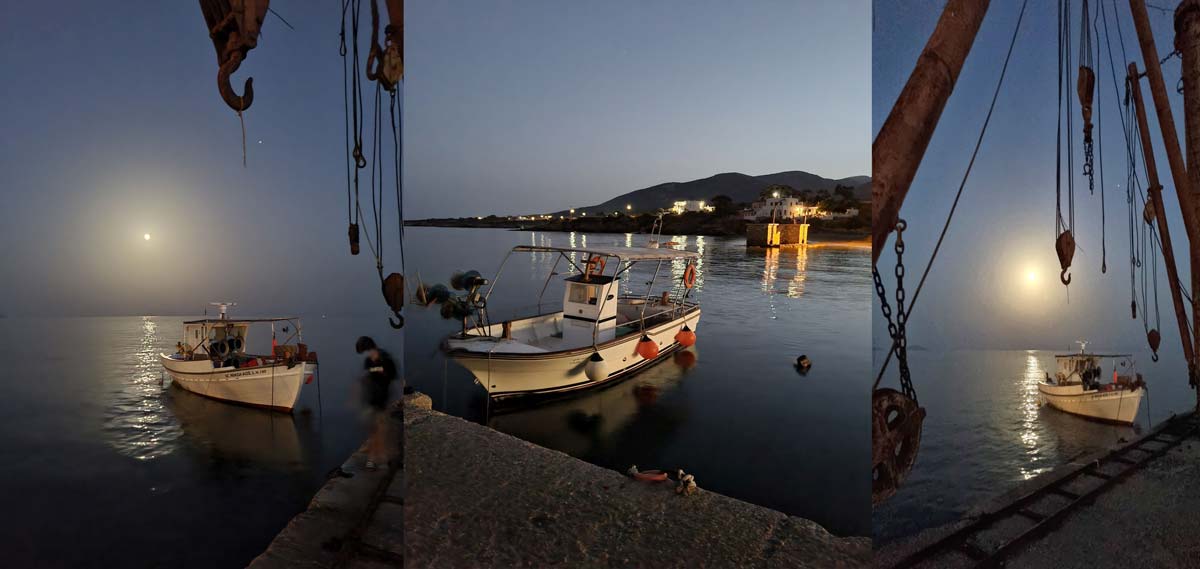Moutsouna is a fishing village and a beach, is located 37 Km on the east coast from Naxos town, and 16 Km from ELaiolithos. You can acess Moutsouna from Apirathos village via an asphalt road all along, The route from Apeirathos, at 650 m altitude, to sea level Moutsouna beach, is narrow, steep with tight hairpin bends, but it’s worth the effort. Drive carefully at low speed, and enjoy amazing vistas of the Small Cycladic islands and the Aegean sea, Some arrive here by boat or yacht due to the existence of a small port available for mooring here. Moutsouna beach, and its surroundings, is a charming isolated quiet area, very close to the unspoiled endless sandy beaches of Naxos east coast.

Moutsouna is a place reminiscent nostalgic times gone by. One can still see in place remnants of the emery train, the cable car systems, and mining towers. Until the mid-20th century, one of the main goods that Naxos exported was emery, a heavy glitzy mineral, with extremely strength, hardness, and durability. Emery as you might not know, it’s the 2nd most hard stone in the world after the diamond. Yes, indeed it is! Moutsouna beach then served as an export port.
There’re quite a few reasons to visit Moutsouna while on Naxos
Some Moutsouna beach history
Constructed 1926-1929 and started to work in 1930, a funicular was built to carry emery from the emery mines down to the port. It was one of the most modern technological feats of the times, and was received with great pride. The emery mines date back to the Bronze Age. The economy of the villages in the area was for long dependent on the emery mine operation, and to nowdays stories and legends still heard about the countless hardships and hazards the miners had faced. About 50 mines have been operating to recent years, featuring narrow entry points and labyrinthine galleries. Workers mined emery by building tunnels to 600 meters deep. The air cable-car net was active till 1978 and is one of the few survivors in Greece. Until the middle of the 20th century, emery exploitation was the main commercial activity for the villages of Apeiranthos, Koronos and Moutsouna, that brought significant wealth to them.

Some information about studies for emery mining in Naxos can be found here
You can read about few stories here
Unfortunately, the production of artificial, low cost emery decreased the demand for the naturally sourced emery mineral, and eventually caused the closure of the mines and the air funicular. Along the road that leads to Moutsouna you can still see the wagons that once carried the cargos, rusted and standing still. Recently a monument was raised in the small port in Moutsouna beach center, honoring the mine workers, with a map close to it indicating the funicular route, while the cranes and part of the stone loading platform still remain.
Emery is a rare mineral used as an abrasive and polishing for metals, glass, wood or rocks, but also as a non-slip material for floors and roads. Components of emery are corundum, magnetite, hematite, diasporus, tourmaline, margarite and others. Its quality depends on its corundum content.
The emery mines of Naxos have been declared preserved by the Ministry of Culture and are an important monument of the modern industrial history of Greece. Emery of the island for a long period was one of the most important Greek minerals, and Naxos is the only Emery-producing region in Europe.

In recent years Moutsouna beach has become very popular to tourists. There is no public transportation to this area, and visitors are arriving here by a rental car or motorbike. Moutsouna beach is not organized, no umbrellas or sunbeds are available for rent. The picturesque Moutsouna beach bay, with shallow clear, calm waters is ideal for swimming even when winds are strong.
There’re quite a few accommodations here to rent, several taverns with local cuisine and picturesque views towards the pier and the beach. Fresh fish is usually the dish of the day here, and the tavernas are loved by locals and tourists alike. While sitting here, the old rusted immovable cranes grab your attention. They are the focal point of Moutsouna beach, and they make an interesting contrast with the vivid image of children running and diving from the dock, a classic image of what a Greek carefree summer means.
When holidaying on Naxos island, neither the distance nor the steep road prevents people from getting to Moutsouna beach.
You might want to investigate the old emery mines while here. From Moutsouna to Panormos beach , it’s 25 Km driving excellent asphalt road all along. On the way there, the coastal road unfolds a series of isolated and secluded sandy beaches, each having its own unique characteristics and orientation, while getting views of all the neighboring Cycladic islands







